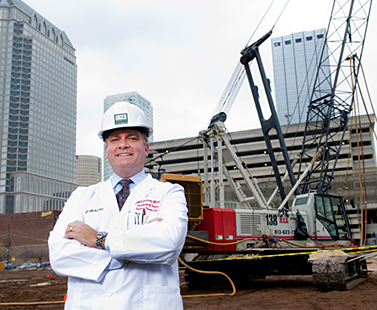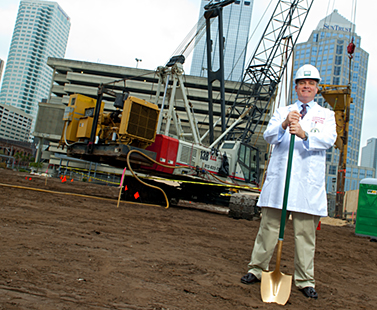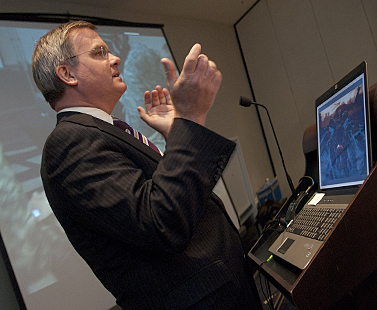Training teams to save lives

Dr. John Armstrong, new medical director of the USF Health Center for Advanced Medical Learning and Simulation, at the downtown Tampa construction site. CAMLS is slated to open in spring 2012.
The stories of certain patients stayed with Dr. John Armstrong as he trained to become a trauma surgeon.
They were the patients who might just as easily have died.
But they lived.
And because they lived, Dr. Armstrong found himself turning their stories over and over, like pieces to a puzzle that could fit together to answer a question: How do we save lives?
Dr. Armstrong would lace up his running shoes and go out for a run. As he settled into his stride, he would find himself reflecting again and again on a growing list of patient cases:
The motorcyclist who crashed and lost both his legs below the knee.
The woman whose boyfriend’s knife sliced her heart, which stopped beating as she arrived at the trauma center.
The unlucky sword collector who, while trying to sheath his cutlass, missed, stabbing his groin and cutting his femoral artery and vein.
The man in the rollover crash, who came in with a barely detectable pulse and a pulverized spleen.
As he paced off the miles, he wondered what led to their survival. It was tempting to think that they owed their lives to the heroic efforts of a dedicated young surgeon.
But Dr. Armstrong recognized that there was more to the story. “The reality is that everyone who touched that patient made a difference,” he said. “And we were connected in a way that made it work.”
That realization has shaped Dr. Armstrong’s career, leading him to focus on teaching teams of health professionals how to save lives by working together better. Along the way, he has led the U.S. Army Trauma Training Center, based in Miami, a center that has become nationally known for its team training expertise.
Now, Dr. Armstrong has brought the same team training mindset to USF Health at the USF Health Center for Advanced Medical Learning and Simulation, or CAMLS.
Dr. Armstrong joined USF Health a few months ago to become CAMLS’ medical director, as well as surgical director of the American College of Surgeons Accredited Education Institute. In between those duties, he is a practicing trauma surgeon at USF’s primary teaching partner, Tampa General Hospital.
“If it’s possible to be beyond state-of-the-art, that’s actually what this center will be,” Dr. Armstrong said of CAMLS. “I believe in this project because I see what it’s going to do to transform the lives of patients.”
***
How ambitious is CAMLS? This new-to-Tampa doctor likes to point to Tampa’s newest tourist landmark to answer that question. CAMLS will be so big, Dr. Armstrong likes to joke, that it will be the size of not one…not two…but three homes of Derek Jeter.
The Yankees’ star player’s waterfront home is just over 30,000 square feet. CAMLS, which is now under construction in nearby downtown Tampa, will be 90,000.
Dr. Armstrong has been going around USF Health town, talking to civic groups about the value of CAMLS. Everywhere he goes, a gold shovel from the CAMLS groundbreaking ceremonies goes along.

CAMLS construction site. Hard hat. Shovel.
Why the shovel? “Because as CAMLS rises from the ground, we need to focus on what we will be doing in CAMLS, on building the transformational programs to fill this incredibly impressive facility,” Dr. Armstrong said. “It’s the CAMLS programming, through the facility, with USF Health faculty and resources, our partner hospitals, and industry collaborators, that will make the difference.”
Plans call for more than 60,000 learners to come to CAMLS each year for education and training activities, from courses on inter-professional team training and advanced surgical techniques (using state-of-the-art surgical robots and simulators), to research and innovation for the next generation of medical devices and simulation technology. CAMLS will facilitate the definition and assessment of competency across learners.
USF leaders believe that Dr. Armstrong will be a key factor in making CAMLS successful.
“We are pleased to welcome Dr. Armstrong to USF Health and to a leadership role with CAMLS and our American College of Surgeons Accredited Educational Institute,” said Debbie Sutherland, PhD, CEO of CAMLS and the force who guided CAMLS from ambitious dream to construction reality.
“His experience with team training, involvement with the military and numerous specialty societies, and his dedication to academic and clinical excellence will greatly contribute to our achieving national and global prominence for activities held at CAMLS,” Dr. Sutherland said.
“He’s got the trifecta,” said Dr. David J. Smith, chair of the USF Department of Surgery. “John did this in the military. He’s well-connected with the American College of Surgeons. He’s a great trauma surgeon. On top of that, he’s a nice guy.”
Ultimately, Dr. Armstrong said, it is patients who will benefit from the work done at CAMLS.
“The goal of CAMLS is to improve outcomes for patients by improving outcomes for learners across all health care professions. This mindset incorporates undergraduate, graduate, and continuing professional education,” he said.
***
An Army brat, Dr. Armstrong has lived in 25 different states, which included going to a different high school each year as a teen.
He returned to the Army as a doctor, following Princeton University and the University of Virginia School of Medicine on Army ROTC and health professions scholarships, respectively. He trained in surgery at Tripler Army Medical Center in Honolulu, Hawaii, and in trauma at University of Miami/Jackson Memorial Hospital.
Dr. Armstrong held various leadership positions in the Army before taking charge of the Trauma Training Center in Miami to train Army Forward Surgical Teams for deployment to the combat zone. The work was intense: imagine taking 20 people—surgeons, anesthetists, nurses, and medics–who often had never worked together, and helping them develop into a smoothly functioning team, while caring for real patients, in a real trauma center, in two weeks, all to ensure that they were capable of treating the most severely injured patients imaginable under the most demanding circumstances imaginable.

U.S. Army Reserve medics work as a team to perform a needle decompression on the CAE Caesar patient simulator now housed at a facility that’s a prototype for CAMLS, the USF Health Simulation Center at Tampa General Hospital.
Often, the units who came to the center had never been to the front lines. Sometimes, they had – and it didn’t always go well. This came out during a rotation in Miami when a combat-tested team cared for a patient who presented with a gunshot wound to the abdomen and severe bleeding from intestinal injuries.
“That patient not only survived in the resuscitation center, but that patient survived in the operating room, and then that patient lived to walk out of the trauma center,” Dr. Armstrong said.
At the end-of-rotation debriefing session, one of the medics brought up a soldier who had died in the field with hemorrhage from severe intestinal injuries. Everyone in the unit knew who he meant, even those who hadn’t been there.
Then he brought up their most recent patient – the one who had lived with injuries similar to the one who didn’t.
“You know, it turns out that we’re better now than we were then,” he told the group.
“That was one of the moments,” Dr. Armstrong said, “that told me we were on the right track.”
The group had come full circle. There they were, with Dr. Armstrong, talking about their patients, and – just as he had in his training fellowship – realizing why patients who could easily have died lived instead. “It takes a well-trained team, to provide safe, effective, efficient care that saves lives.”

Dr. Armstrong speaking at the Caesar simulator event.
***
So what’s the secret of teaching medical teams to save those lives?
Good team training comes back to one of the oldest adages in modern medicine, said Dr. Armstrong. It’s what Dr. Francis Weld Peabody told students at Harvard in 1925 in his address, “The Care of the Patient.” As he moved through a series of possibilities, he came to this conclusion: “The secret of the care of the patient is caring for the patient.”
“In the end, teamwork keeps care focused on the patient,” Dr. Armstrong said. “When there are teams that are dysfunctional, it typically relates to assorted distractions that take the focus away from the patient.”
The specifics are different, but poorly functioning teams share similar problems: unknown roles, personality conflicts, ego clashes, lack of respect, uncontrolled chaos, and poor communication.
It will be part of Dr. Armstrong’s job to unravel such tangles. He’s confident that at CAMLS, that will be done.
“It’s thrilling to have a venue that will support a type of education and training that will produce better-prepared health professionals,” he said. “We intend to let our state, our nation and the world see how we can make healthcare delivery better.”
— Story by Lisa Greene, photos by Eric Younghans, USF Health Communications

